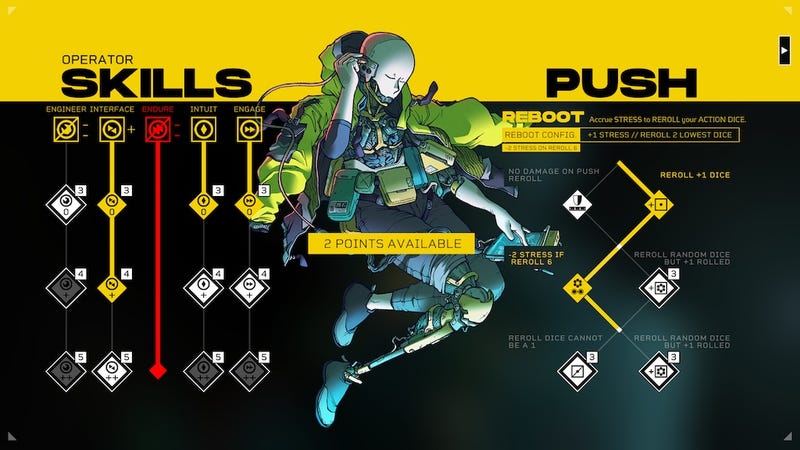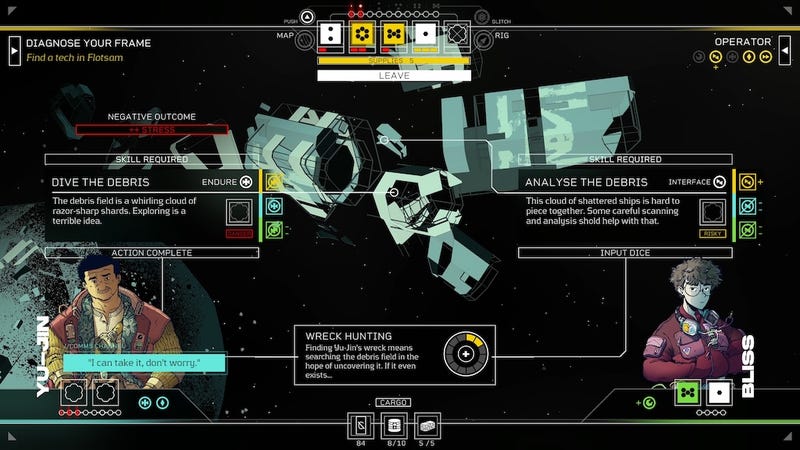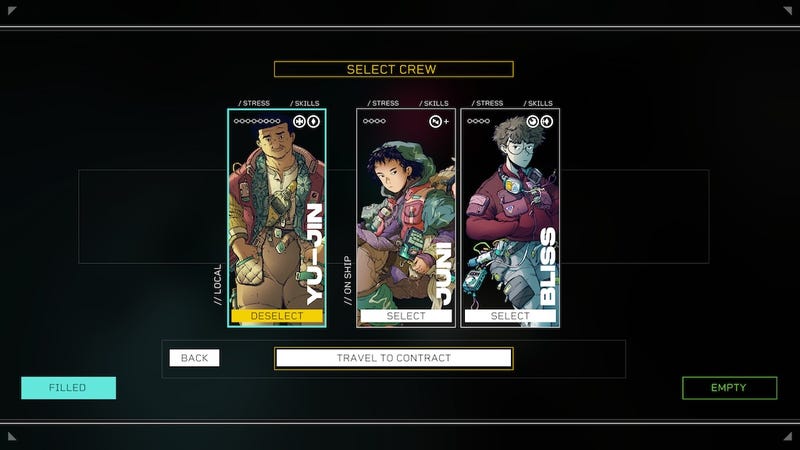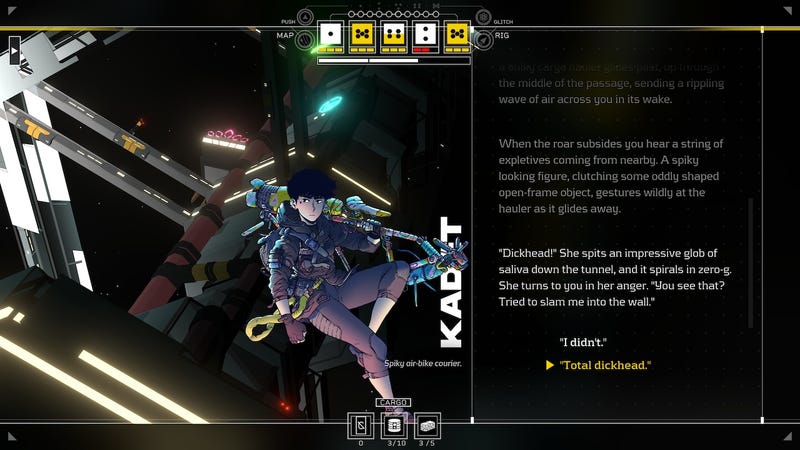As an avid fan of 2022’s Citizen Sleeper and its subsequent DLCs, I consider myself an expert on the narrative-heavy RPG. So when I booted up my first playthrough of the Citizen Sleeper 2: Starward Vector preview build provided by developer Jump Over The Age, I was sure I would make all the right choices. I was wrong.
This first playthrough lasted for about an hour and ultimately ended in me accidentally causing an entire ship to break apart while I was still on it. That’s because I was playing the game like I would its predecessor, something subsequent playthroughs would teach me was a mistake. Starward Vector is a completely different beast than what came before. It’s a shockingly big game with so many new systems to learn. But above all, it’s more dangerous, and I couldn’t be happier about it.
Welcome back Sleeper

Starward Vector’s early moments pick up on a tantalizing loose thread. Where the original game confined its story to a single space station, its final moments teased life beyond The Eye, and a universe made up of many similar spaceports and stations that those lucky enough to have ships could travel between. That is the premise of Starward Vector, which gives your new Sleeper command of one of those prized ships (albeit a slightly banged-up one) with which they can eke out a living while running from their previous owner.
With the aid of a friend and possession of a stolen ship, my Sleeper manages to find brief safety at the beginning of the preview in a small spaceport. Our ship is damaged and we need to repair it and get out of here fast as my previous owner is hunting us down quickly (Sleepers are still a source of slave labor in the universe and considered property). My first drive (or mission objective) is to fix the ship.

Starward Vector is built on the same core systems as the original game: exploring points on a map, completing skill checks with the five available dies provided at the beginning of every cycle, and talking to characters that inhabit the world. While my hands-on preview only consisted of one spaceport and its surrounding area (we will get to that later) developer Gareth Damian Martin showed off a brief look at the larger map of the game over a video call, revealing close to a dozen systems players will eventually be able to travel between, each with their own ports, stations, and stories to uncover.
After working some odd jobs and chatting up workers at the local dive, I find my way to a merchant with the parts I need. I can get it if I have the money (which I obviously do not, as it is hard to come by early on) or I can do a risky salvage job in exchange for the goods I need. Job it is.
Odd jobs

This job is a contract, a new feature in Starward Vector centered around the opportunities owning a ship opens up to you. You’ll have contracts available to complete in the area of space surrounding a port or station, which will reward you with money or resources. This job required me to go out to an abandoned ship and hunt down its core. In my first playthrough, I received this contract and immediately flew out to the ship. Once on the ship, the usual list of tasks pops on screen. After a series of poor rolls,resulting in several failures, I notice a counter quickly creeping up. It indicates the damage to the ship, and I am informed that if that counter reaches its maximum the ship will break apart.
To make it worse, with each cycle I spend on the ship new issues are popping up—including a leak in the hull. This stretches my dice rolls thin as I balance them between finishing the job and keeping the ship together, which is made worse as the job stretches across cycles and my Sleeper starts starving to death because I didn’t properly stock up on supplies. That is where the crisis system comes into play. The more I starve, the more stressed my Sleeper becomes and the riskier dice rolls are. Not because I might fail them, but because a dice might break, making it even more prone to failure. Once it has broken three times, the dice will fully become unusable (until manually repaired).

It’s a dangerous evolution of the stabilizer system which required a steady dose of the rare medication every few cycles in order to keep all of your dice but lacked real friction as you progressed further into the game. The crisis system is a little more luck-based and not as easy to fix when it is so far gone. All of these knocks against me added up and a final failed skill check which caused the ship to break apart and had me quickly flying back to safety with nothing but a failed contract.
In my next playthrough, I learned from my mistakes. I stock up on supplies, which are consumed every cycle while out on a contract, and also made sure to fully explore the port before leaving. This led me to encounter more of the game’s characters, which now have an extra utility not seen in the first game: they can serve as crew members on jobs. Like the Sleeper, characters now have certain affinities for certain skills and when on a job they even get to roll two of their own dies for you to use as you see fit. It helps give you an edge on tough jobs. But characters aren’t just tools for you to use for your benefit.
I’m putting together a crew

The people you meet in the original Citizen Sleeper were a major highlight of the game. Amongst Starward Vector’s stars, that still holds true, and each character has their own motivations and desires. As the captain of a ship, you have something people want and they will try to use you the way you are using them. They also have their own baggage. Picking up certain crew members will inadvertently get you put on somebody’s shit list, which will bite you in the ass later if you aren’t careful. You also have to play peacekeeper between your crew, as not everybody gets along. This system is a direct response to Gareth Damian Martin’s criticism of RPGs like Mass Effect 2, which they see as casting the player as a glorified super cop who doesn’t take the party’s feelings into account. Previously they joked that Commander Shepard reminds them of bosses they’ve had (not in a good way) and Starward Vector challenges the player to not be that shitty boss. Even while you are on the run, you have a newfound responsibility to your crew
Some crew will be locked to certain stations, while others have ships of their own and will wander the systems at the same time you do, only briefly crossing paths in your narrative. To further boost the risk of character interaction the dialogue moments of the game are occasionally interspersed with choices tied to skill checks, a new feature in Starward Vector. Juni, a crew member I had picked up for the risky salvage job, revealed to me during our mission that she was taking the salvage for herself. This put us in conflict and I was given the option to attempt to wrestle the core from her. It felt like a desperate action, but my Sleeper’s life was in danger so I made that choice. I held my breath as I waited for the skill check and released it when I succeeded. But I felt like absolutely shit after I then left Juni on the abandoned ship as punishment for her betrayal. I had succeeded in the mission but still felt like I had lost, and the moment-to-moment of the job’s many cycles was still full of tension.
High-risk, high-reward

That tension is the defining feeling of Starward Vector. Every choice is a gamble, and the game encourages players to risk everything. Sure you might break your dice due to the crisis system, but just imagine if you get the perfect roll and complete that lucrative job. It could turn everything around. It’s intoxicating
After spending a handful of hours playing and replaying Starward Vector’spreview build was shocked by how many more systems are in this game than its predecessor. It feels like a response to how the original game was perceived. While Citizen Sleeper is an RPG heavily styled after tabletop games, the narrative-heavy experience was often mistaken for a visual novel.
The expansive world, the crew and crisis system, captaining a ship,—these all signal that Starward Vector is an RPG. That’s the dream of Gareth Damian Martin. “I want to see people going ‘I finished Baldur’s Gate 3, what do I play next?’ And people say Citizen Sleeper 2,” they confess, “I want it to be absolutely irrefutable that Citizen Sleeper 2 is an RPG.”
Based on what I’ve played so far, I can say that nobody will be able to make that mistake, and that bold comparison to 2023’s most impressive RPG may not be as lofty as you expect. For now, I’ll have to patiently wait to get back to my journey amongst the stars when Citizen Sleeper 2: Starward Vector releases in early 2025.
.

Leave a Reply